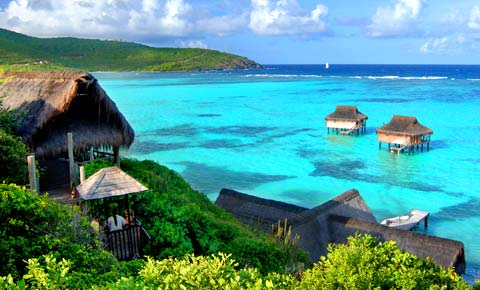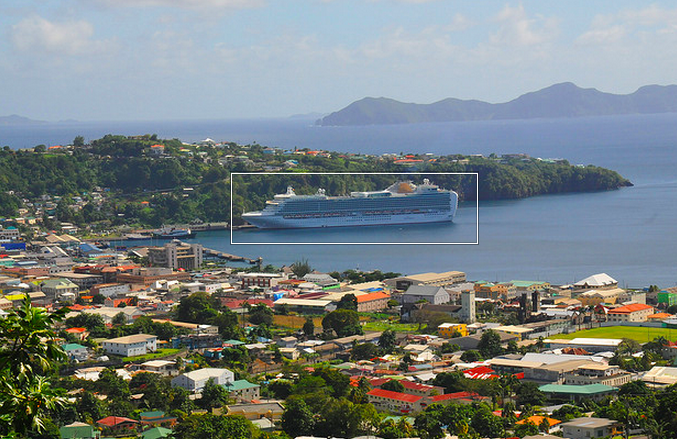Saint Vincent and the Grenadines' Second National Communication
Project Overview
The creation of a National Communication offers countries the opportunity to contribute with technically sound studies and information that can be used for designing mitigation and adaptation measures, and project proposals that can and will help increase their resilience to the impacts of climate change. Activities generally include: V&A assessments, Greenhouse Gas Inventory preparation, Mitigation Analysis or Education, and awareness raising activities. The ultimate goal is the integration of climate change considerations into relevant social, economic and environmental policies and actions.
The island nation is feeling the effects of warming temperatures and more extreme weather. There is evidence that fish are retreating into deeper and cooler waters, and the islands of the Grenadines, which have no surface water, are beginning to experience saltwater intrusion into their groundwater supplies. The country’s coastal areas are particularly vulnerable to the effects of sea level rise; 85 per cent of the population and 90 per cent of the country’s infrastructure inhabit a narrow coastal strip that is less than five meters above sea level and under five kilometers from the high-water mark. The local economy remains vulnerable to the impacts of variable precipitation, extreme weather events and increased evapotranspiration. Both the nation’s water resources are also noted as being particularly vulnerable, along with energy resources.
To view progress on Saint Vincent and the Grenadines' SNC click here.
Project Details
Saint Vincent and the Grenadines is an island archipelago located in the Caribbean Sea. With a total land area of 340 square kilometers and 84 kilometers of coastline, the nation consists of over 30 islands, inlets, and cays, some of which are privately owned (MHE, 2000; USDS, 2010). The country’s climate is tropical and the terrain of its islands are volcanic and mountainous (USDS, 2010). The main island of Saint Vincent is characterized by rugged, mountainous terrain with valleys that drain to the narrow coastal area, as well as wet upland forests, numerous rivers, and fertile soils (MHE, 2000). The islets and cays that form the Grenadines are smaller and less rugged than Saint Vincent; these islands are nearly entirely dependent on groundwater for their freshwater supply given a lack of rivers and lakes (MHE, 2000).
The country’s population is approximately 104,500, with adult literacy at 88.1 per cent and per capita Gross Domestic Product approximately US$18,100 (USDS, 2010). The country’s economy is highly dependent on tourism and agricultural production; approximately 60 per cent of the workforce is employed by banana production, and the industry accounts for 50 per cent of the island nation’s exports. Efforts to diversify the economy have been made in recent years (USDS, 2010).
St. Vincent and the Grenadines First National Communication was completed in 2000 and was prepared in conjunction with the regional programme for the Caribbean: Planning for Adaptation to Global Climate Change (CPACC). As part of this initiative, a climate-monitoring station was established off the southwest coast of St. Vincent to compile a historical record of environmental change. The country also participated in a series of regional efforts to establish database and information systems, inventory coastal resources and uses, and formulate a policy framework for integrated coastal and marine management. Pilot studies were done on coral-reef monitoring for climate change, coastal vulnerability and risk assessment, economic valuation of coastal and marine resources, and formulation of economic/regulatory proposals.
Specific adaptation measures that have been/are being pursued by St. Vincent and the Grenadines include:
- Revision and enforcement of the Town and Country Planning Act, establishing land use as a high priority with sound land-use controls along with flexibility to address the dynamic aspects of long-term shoreline retreat and climatic change.
- Strengthening of the building codes and the initiation of builder certification to assure that adequate construction standards are being met.
- The development of a thorough vulnerability assessment as a basis for land-suitability and hazard mapping.
- The formulation of a coastal management programme with permitting authority and incentive-based criteria for coastal development that sends the right signals to the development community.
- Agricultural reform that promotes a strong, viable agricultural base able to adapt to changing climatic conditions, including the development of in situ seed-bank and tissue-culture development centres for the preservation of plant genetic information.
- Protection of water-supply sources and improved harnessing and distribution systems to accommodate competing uses with increasing water demand and water supply variability.
- The enhancement of water quality, addressing municipal and industrial discharges and urban and agricultural runoff.
- An expansion of the country’s environmental education programme that speaks to climate change, vulnerability, sustainability , human health, and safety.
- The provision of incentives for investment in renewable energy, including solar and wind energy and hydrogen-fuel-based transportation.
- The strengthening and equipping of the local vector-control unit to respond to expanding insect populations and the emergence or re-emergence of vector-borne diseases.
- Greater emphasis on heritage and eco-tourism to supplement beach tourism.
Adaptation Needs and Priorities
The island nation is feeling the effects of warming temperatures and more extreme weather; there is evidence that fish are retreating into deeper and cooler waters, and the islands of the Grenadines, which have no surface water, are beginning to experience saltwater intrusion into their groundwater supplies (Gonsalves, 2007). The country’s coastal areas are particularly vulnerable to the effects of sea level rise; 85 per cent of the population and 90 per cent of the country’s infrastructure inhabit a narrow coastal strip that is less than five meters above sea level and under five kilometers from the high-water mark (MHE, 2000). These challenges are particularly significant for the islands of Grenadines, which are dependent upon their natural resources—white beaches, coral reefs and fisheries—to sustain the local economy (MHE, 2000). Given the importance of agriculture to the country’s economy, this sector is also noted in the country’s Initial National Communication to the United Nations Framework Convention on Climate Change (UNFCCC) as being particularly vulnerable to the impacts of climate change, including variable precipitation, extreme weather events and increased evapotranspiration (MHE, 2000). The nation’s water resources are also noted as being particularly vulnerable, along with energy resources (MHE, 2000).
National Level Policies and Strategic Documents
Saint Vincent and the Grenadines has prepared an Initial National Communication for the UNFCCC. In addition, as part of the “Mainstreaming and Adaptation to Climate Change” project, Saint Vincent and the Grenadines undertook to develop and mainstream climate change adaptation strategies into its sustainable development agenda. A National Climate Change Adaptation Strategy, National Disaster Management Plan (2010-2012), and a National Environment Management Strategy also are reported to have been established (CIF, 2011).
Current Adaptation Action
There are currently a moderate number of adaptation projects occurring or recently completed within Saint Vincent and the Grenadines. These project activities are all regional or global in nature and most commonly focus on the areas of coastal zones management and building the capacity of government to facilitate adaptation to climate change. Notably, the country was one of three Caribbean countries to receive funding through the “Special Program on Adaptation to Climate Change,” a regional project that aims to reduce vulnerability within the areas of coastal zones, land management, and biodiversity.
Proposed Adaptation Action
It does not appear that Saint Vincent and the Grenadines has proposed to undertake concrete climate change adaptation projects.
Assessment
Based on information presented in a recent government document, it appears that Saint Vincent and the Grenadines has made considerable efforts to address adaptation through policy initiatives, including establishment of a National Adaptation Strategy and a National Environmental Management Strategy. The country is also benefiting from participation in a number of the main Caribbean adaptation projects, including the MACC and SPACC projects. Saint Vincent and the Grenadines’ inclusion in the latter project likely reflects its particular vulnerability to climate change given its low-lying coastal areas, the limited water supply of the Grenadines, and the country’s dependence on tourism to support its economic activity. Ongoing projects in the country address priority adaptation needs as discussed in the National Communication, including freshwater resources, agriculture, tourism and coastal zones. Current initiatives are also addressing the need for policy formation and integration to address climate change, as well as risk reduction measures. Future project initiatives may move from capacity building and vulnerability assessments towards greater implementation of activities at the field level. In the country’s coastal zones, for example, this could involve investments in the integrated planning and physical infrastructure needed to reduce coastal vulnerability to sea level rise, storm surge and other expected impacts of climate change.
References:
- Medeiros, Hove, Keller, Echeverría, Parry (2011) “Review of Current and Planned Adaptation Action: The Carribean.” Adaptation Partnership / International Institute for Sustainable Development.
- Climate Investment Funds [CIF] (2011). Pilot Program for Climate Resilience: Second Joint Mission Report, Saint Vincent and the Grenadines. Retrieved fromhttp://www.climateinvestmentfunds.org/cif/sites/climateinvestmentfunds.org/files/SVG_Final%20Aide%20Memoire_%20PPCR%202nd%20Joint%20Mission.pdf
- Gonsalves, Camillo M. (2007). Preparing for Bali and Beyond: The human dimension of climate change. Statement by Permanent Representative of Saint Vincent and Grenadines to the United Nations. Retrieved from http://www.svg-un.org/downloads/maldivesstatement.pdf
- Ministry of Health and Environment [MHE] (2000). Initial National Communication: Saint Vincent and the Grenadines. Retrieved fromhttp://unfccc.int/resource/docs/natc/svgnc1.pdf
- United States Department of State [USDS] (2010). Background Note: Saint Vincent and the Grenadines. Retrieved fromhttp://www.state.gov/r/pa/ei/bgn/2345.htm
Key Results and Outputs
- Sustainable development and the integration of climate change concerns into medium- and long-term planning
- Inventories of anthropogenic emissions by sources and removals by sinks of greenhouse gases
- Measures contributing to addressing climate change
- Research and systematic observation
- Climate change impacts, adaptation measures and response strategies
- Education, training and public awareness
Potential Adaptation Measures:
- Revision and enforcement of the Town and Country Planning Act, establishing land use as a high priority with sound land-use controls along with flexibility to address the dynamic aspects of long-term shoreline retreat and climatic change.
- Strengthening of the building codes and the initiation of builder certification to assure that adequate construction standards are being met.
- The development of a thorough vulnerability assessment as a basis for land-suitability and hazard mapping.
- The formulation of a coastal management programme with permitting authority and incentive-based criteria for coastal development that sends the right signals to the development community.
- Agricultural reform that promotes a strong, viable agricultural base able to adapt to changing climatic conditions, including the development of in situ seed-bank and tissue-culture development centres for the preservation of plant genetic information.
- Protection of water-supply sources and improved harnessing and distribution systems to accommodate competing uses with increasing water demand and water supply variability.
- The enhancement of water quality, addressing municipal and industrial discharges and urban and agricultural runoff.
- An expansion of the country’s environmental education programme that speaks to climate change, vulnerability, sustainability , human health, and safety.
- The provision of incentives for investment in renewable energy, including solar and wind energy and hydrogen-fuel-based transportation.
- The strengthening and equipping of the local vector-control unit to respond to expanding insect populations and the emergence or re-emergence of vector-borne diseases.
- Greater emphasis on heritage and eco-tourism to supplement beach tourism.
Monitoring and Evaluation
In 1992, countries joined an international treaty, the United Nations Framework Convention on Climate Change, to cooperatively consider what they could do to limit average global temperature increases and the resulting climate change, and to cope with whatever impacts were, by then, inevitable.
Parties to the Convention must submit national reports on implementation of the Convention to the Conference of the Parties (COP). The required contents of national communications and the timetable for their submission are different for Annex I and non-Annex I Parties. This is in accordance with the principle of "common but differentiated responsibilities" enshrined in the Convention.
The core elements of the national communications for both Annex I and non-Annex I Parties are information on emissions and removals of greenhouse gases (GHGs) and details of the activities a Party has undertaken to implement the Convention. National communications usually contain information on national circumstances, vulnerability assessment, financial resources and transfer of technology, and education, training and public awareness.
Since 1994, governments have invested significant time and resources in the preparation, collection and validation of data on GHG emissions, and the COP has made determined efforts to improve the quality and consistency of the data, which are ensured by established guidelines for reporting. Non-Annex I Parties receive financial and technical assistance in preparing their national communications, facilitated by the UNFCCC secretariat.





